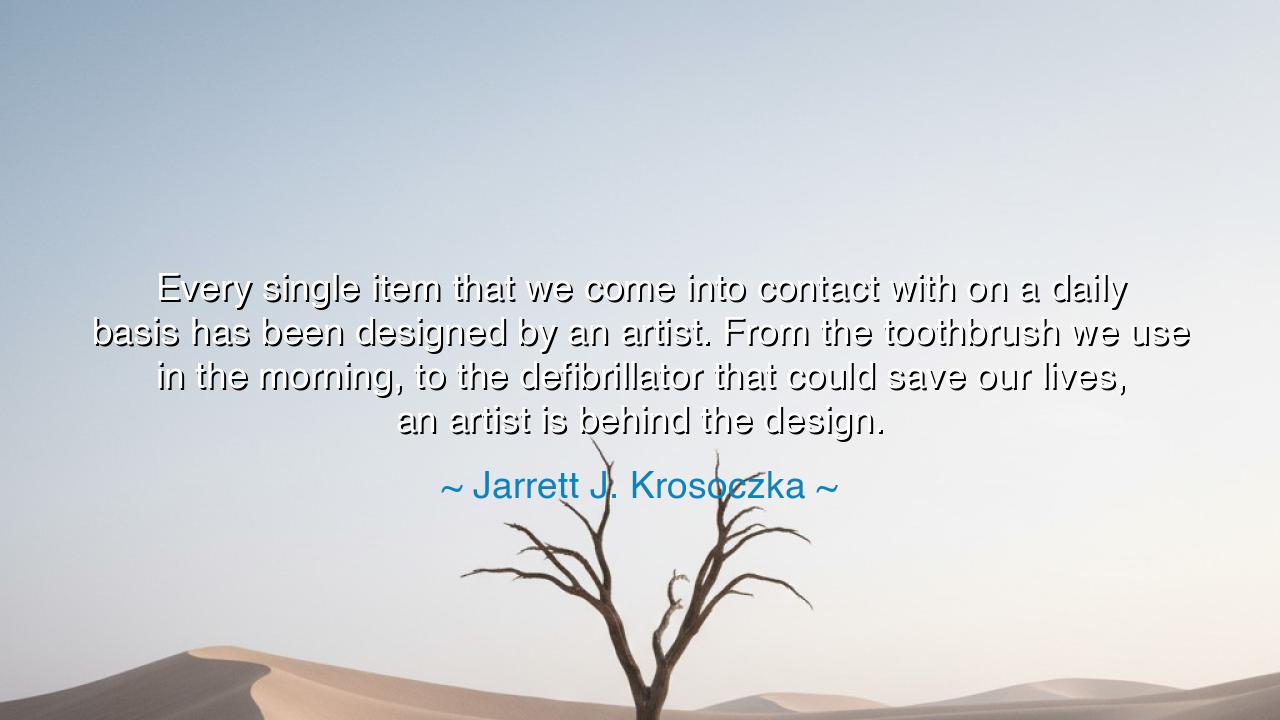
Every single item that we come into contact with on a daily basis
Every single item that we come into contact with on a daily basis has been designed by an artist. From the toothbrush we use in the morning, to the defibrillator that could save our lives, an artist is behind the design.






“Every single item that we come into contact with on a daily basis has been designed by an artist. From the toothbrush we use in the morning, to the defibrillator that could save our lives, an artist is behind the design.” Thus spoke Jarrett J. Krosoczka, the storyteller and illustrator whose craft celebrates both the imagination and the hands that give it form. In these words lies not only reverence for art, but a profound reminder of the divine presence of creativity that threads through the ordinary world. For Krosoczka sees what many overlook: that art is not confined to museums or galleries—it lives in every corner of human life, shaping the very tools by which we live, survive, and dream.
To say that every object we touch “has been designed by an artist” is to awaken us to the hidden lineage of creation that sustains civilization itself. The toothbrush, humble and unnoticed, carries in its form the thought of a mind that studied comfort, material, and efficiency. The defibrillator, a guardian of the heart, is born not only of science but of empathy—the artist’s will to make something that could save another human being. What Krosoczka reveals is that artistry is not a luxury; it is a force of compassion woven into the structure of our existence. It is through the act of design that humanity transforms chaos into meaning, necessity into beauty.
The origin of this truth reaches deep into history. In ancient times, the craftsman and the artist were one and the same. The potter who shaped the vessel also adorned it; the architect who built the temple carved its columns by hand. In the workshop of Daedalus, mythic father of invention, art and function were inseparable—each invention was an act of imagination as much as utility. And when Leonardo da Vinci sketched his machines of flight and healing, he blurred the boundaries between science and art entirely. His drawings were not just blueprints; they were poems of possibility, visions of how human ingenuity could lift the world closer to divinity.
Krosoczka’s insight reminds us that even now, in our age of technology, the artist’s spirit endures in every invention. The sleek curve of a smartphone, the ergonomics of a chair, the design of a bridge—all bear the mark of human creativity. Behind every object lies the silent labor of someone who imagined how it might be held, used, or admired. Even in the most technical devices, there dwells an element of the aesthetic soul—a desire to bring harmony between function and form. To see this truth is to recognize that art is not separate from life, but the very language through which life expresses itself.
Consider the story of Raymond Loewy, the industrial designer who transformed the 20th century. It was he who shaped the look of trains, cars, and even spacecraft. He once said, “Ugliness does not sell,” not as a mere commercial truth, but as a testament to the human longing for beauty in all things. When he designed the streamlined locomotives that carried people across continents, he was not only improving efficiency—he was lifting the human spirit, turning travel into poetry. His work embodied Krosoczka’s belief: that every designed object, from the most trivial to the most profound, carries within it the soul of an artist reaching toward grace.
And yet, this truth demands something of us as well: awareness. Too often we live surrounded by the fruits of design and never pause to see them. The handle that fits the palm, the typeface that comforts the eye, the colors that calm the mind—these are not accidents, but gifts of thought and care. To live well, we must learn to look again, to move through our days with gratitude for the unseen artists who shape our world. To see beauty in the practical is to walk through life awake.
The lesson of Krosoczka’s words is simple, yet profound: honor the creators, and create in turn. Whether you draw, build, cook, or simply arrange the space around you, remember that to design is to participate in the sacred work of making life more livable, more meaningful, more beautiful. Every act of design, no matter how small, is a defiance of chaos—a declaration that care and creativity matter.
And so, let Jarrett J. Krosoczka’s wisdom guide us. Let us remember that the world itself is a gallery, filled with the art of countless unseen hands. The toothbrush and the defibrillator, the skyscraper and the spoon—all whisper the same truth: that humanity’s greatest power is not destruction, but creation. To design, to make, to imagine—these are the acts that define us. And when we recognize that even the simplest object is born from the heart of an artist, we begin to live not merely as consumers of the world, but as custodians of its beauty.






AAdministratorAdministrator
Welcome, honored guests. Please leave a comment, we will respond soon